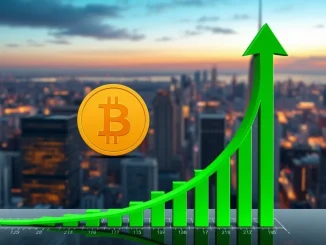
Bitcoin (BTC) is sending shockwaves through the crypto sphere as it teeters on the brink of concluding its weakest first quarter since 2018. As March draws to a close, the leading cryptocurrency is facing a significant downturn, leaving traders and investors on edge. What’s fueling this alarming BTC price decline and what does it mean for the future of crypto markets? Let’s delve into the factors contributing to this critical juncture.
Why is Bitcoin’s Q1 Performance So Concerning?
According to recent reports from Cointelegraph, Bitcoin is currently on a trajectory to close the last trading day of March in the red. This potential downturn isn’t just a minor blip; it signifies a potentially historic low for Bitcoin Q1 performance, marking the worst start to a year since 2018. The numbers paint a stark picture: Bitcoin’s price has been on a continuous slide for seven days, plummeting to $81,656 as of March 30th. This sustained downward pressure is causing considerable anxiety within the crypto community. But what’s behind this bearish trend?
Trump Tariffs Trigger Crypto Market Analysis and Bitcoin Price Decline
One of the key catalysts contributing to the current market unease is the resurgence of trade war anxieties. U.S. President Donald Trump’s recent announcement of a 25% tariff on imported cars, coupled with the looming threat of tariffs on the pharmaceutical industry, has sent ripples of apprehension across global markets. This protectionist stance has further been amplified by Trump’s cryptic reference to April 2nd as “Liberation Day,” hinting at the potential unveiling of even more reciprocal tariffs. This anticipation of escalating trade tensions is significantly undermining trader confidence and impacting investment decisions across various asset classes, including cryptocurrencies.
The impact of these tariff threats is already visible in traditional financial markets. Stock futures have reacted negatively, with DOW futures plummeting by 206 points and S&P futures decreasing by 0.56%. Interestingly, the price of Bitcoin has mirrored this downturn in equities, reinforcing the growing correlation between traditional markets and the cryptocurrency space. This synchronization suggests that broader economic concerns are now heavily influencing crypto market analysis and investor sentiment towards Bitcoin.
Decoding Market Uncertainty and Its Impact on Bitcoin
The current market climate is characterized by significant market uncertainty. Trump’s tariff announcements have injected a dose of unpredictability into the global economic outlook. Investors are now grappling with the potential consequences of these trade policies, including:
- Increased Inflation: Tariffs can lead to higher import costs, potentially fueling inflationary pressures within the U.S. economy.
- Slower Economic Growth: Trade disputes can disrupt global supply chains and dampen economic activity, impacting growth prospects.
- Geopolitical Risks: Escalating trade tensions can heighten geopolitical risks and create a less stable investment environment.
This pervasive uncertainty is prompting investors to reassess their risk exposure and, in many cases, reduce their holdings in riskier assets like cryptocurrencies. Bitcoin, despite its growing adoption, is still perceived as a volatile asset class, making it particularly vulnerable during periods of economic anxiety. The fear of further market corrections is leading to a cautious approach among traders, contributing to the ongoing BTC price decline.
Navigating the Bitcoin Decline: Key Takeaways for Crypto Traders
In these turbulent times, what should crypto traders and investors do? Here are some key takeaways:
- Stay Informed: Keep a close watch on macroeconomic developments, particularly updates on trade policies and their potential impact on global markets.
- Manage Risk: Assess your portfolio risk and consider adjusting your positions to mitigate potential losses during periods of high volatility.
- Diversify: Diversification remains a crucial strategy. Consider spreading your investments across different asset classes to reduce reliance on any single market.
- Long-Term Perspective: Remember that market corrections are a natural part of the investment cycle. Maintain a long-term perspective and avoid making impulsive decisions based on short-term market fluctuations.
Conclusion: Bitcoin’s Critical Q1 Close Demands Attention
Bitcoin’s potential worst Q1 performance since 2018 serves as a stark reminder of the cryptocurrency market’s sensitivity to global economic and political events. The confluence of Trump’s tariff threats and the resulting market uncertainty has created a challenging environment for BTC. As we approach the end of March and look towards “Liberation Day,” the crypto community will be keenly observing market reactions and assessing the long-term implications of these developments. Whether this downturn is a temporary setback or the start of a more prolonged bearish phase remains to be seen. However, one thing is clear: the current situation demands careful monitoring and strategic navigation from all participants in the crypto market.



